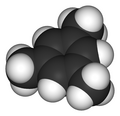Top Qs
Timeline
Chat
Perspective
Mesitylene
Chemical compound From Wikipedia, the free encyclopedia
Remove ads
Mesitylene or 1,3,5-trimethylbenzene is a derivative of benzene with three methyl substituents positioned symmetrically around the ring. The other two isomeric trimethylbenzenes are 1,2,4-trimethylbenzene (pseudocumene) and 1,2,3-trimethylbenzene (hemimellitene). All three compounds have the formula C6H3(CH3)3, which is commonly abbreviated C6H3Me3. Mesitylene is a colorless liquid with sweet aromatic odor. It is a component of coal tar, which is its traditional source. It is a precursor to diverse fine chemicals. The mesityl group (Mes) is a substituent with the formula C6H2Me3 and is found in various other compounds.[4]
Remove ads
Preparation
Mesitylene is prepared by transalkylation of xylene over solid acid catalyst:[4]
- 2 C6H4(CH3)2 ⇌ C6H3(CH3)3 + C6H5CH3
- C6H4(CH3)2 + CH3OH → C6H3(CH3)3 + H2O
Although impractical, it could be prepared by trimerization of propyne, also requiring an acid catalyst, which yields a mixture of 1,3,5- and 1,2,4-trimethylbenzenes.
Trimerization of acetone via aldol condensation, which is catalyzed and dehydrated by sulfuric acid is another method of synthesizing mesitylene.[5]
Remove ads
Reactions
Oxidation of mesitylene with nitric acid yields trimesic acid, C6H3(COOH)3. Using manganese dioxide, a milder oxidising agent, 3,5-dimethylbenzaldehyde is formed. Mesitylene is oxidised by trifluoroperacetic acid to produce mesitol (2,4,6-trimethylphenol).[6] Bromination occurs readily, giving mesityl bromide:[7]
- (CH3)3C6H3 + Br2 → (CH3)3C6H2Br + HBr
Mesitylene is a ligand in organometallic chemistry, one example being the organomolybdenum complex [(η6-C6H3Me3)Mo(CO)3][8] which can be prepared from molybdenum hexacarbonyl.
Remove ads
Applications
Summarize
Perspective
Mesitylene is mainly used as a precursor to 2,4,6-trimethylaniline, a precursor to colorants. This derivative is prepared by selective mononitration of mesitylene, avoiding oxidation of the methyl groups.[9]
Niche uses

Mesitylene is used in the laboratory as a specialty solvent. In the electronics industry, mesitylene has been used as a developer for photopatternable silicones due to its solvent properties.
The three aromatic hydrogen atoms of mesitylene are in identical chemical shift environments. Therefore, they only give a single peak near 6.8 ppm in the 1H NMR spectrum; the same is also true for the nine methyl protons, which give a singlet near 2.3 ppm. For this reason, mesitylene is sometimes used as an internal standard in NMR samples that contain aromatic protons.[10]
Uvitic acid is obtained by oxidizing mesitylene or by condensing pyruvic acid with baryta water.[11]
The Gattermann reaction can be simplified by replacing the HCN/AlCl3 combination with zinc cyanide (Zn(CN)2).[12] Although it is highly toxic, Zn(CN)2 is a solid, making it safer to work with than gaseous hydrogen cyanide (HCN).[13] The Zn(CN)2 reacts with the HCl to form the key HCN reactant and ZnCl2 that serves as the Lewis-acid catalyst in-situ. An example of the Zn(CN)2 method is the synthesis of mesitaldehyde from mesitylene.[14]
History
Mesitylene was first prepared in 1837 by Robert Kane, an Irish chemist, by heating acetone with concentrated sulfuric acid.[15] He named his new substance "mesitylene" because the German chemist Carl Reichenbach had named acetone "mesit" (from the Greek μεσίτης, the mediator),[16] and Kane believed that his reaction had dehydrated mesit, converting it to an alkene, "mesitylene".[17] However, Kane's determination of the chemical composition ("empirical formula") of mesitylene was incorrect. The correct empirical formula was provided by August W. von Hofmann in 1849.[18] In 1866 Adolf von Baeyer gave a correct mesitylene's empirical formula; however, with a wrong structure of tetracyclo[3.1.1.11,3.13,5]nonane.[19] A conclusive proof that mesitylene was trimethylbenzene was provided by Albert Ladenburg in 1874; however, assuming wrong benzene structure of prismane.[20]
- Historical mesitylene structures
- Mesitylene by Adolf von Baeyer (tetracyclo[3.1.1.11,3.13,5]nonane)
- Mesitylene by Albert Ladenburg (1,2,6-trimethylprismane)
Remove ads
Mesityl group
The group (CH3)3C6H2- is called mesityl (organic group symbol: Mes). Mesityl derivatives, e.g. tetramesityldiiron, are typically prepared from the Grignard reagent (CH3)3C6H2MgBr.[21] Due to its large steric demand, the mesityl group is used as a large blocking group in asymmetric catalysis (to enhance diastereo- or enantioselectivity) and organometallic chemistry (to stabilize low oxidation state or low coordination number metal centers). Larger analogues with even greater steric demand, for example 2,6-diisopropylphenyl (Dipp) and the analogously named Tripp ((iPr)3C6H2, Is) and supermesityl ((tBu)3C6H2, Mes*) groups, may be even more effective toward achieving these goals.
Remove ads
Safety and the environment
Mesitylene is also a major urban volatile organic compound (VOC) which results from combustion. It plays a significant role in aerosol and tropospheric ozone formation as well as other reactions in atmospheric chemistry.[citation needed]
References
Wikiwand - on
Seamless Wikipedia browsing. On steroids.
Remove ads



